Professional IT Culture Report: Ethical Dilemmas and SFIA 6
VerifiedAdded on 2023/06/08
|11
|2413
|78
Report
AI Summary
This report delves into the complexities of professional IT culture, examining ethical decision-making and the application of the SFIA 6 framework. The first subtask presents a case study involving an IT professional, exploring ethical dilemmas related to software development and stakeholder responsibilities. It analyzes the ethical response to the dilemma, referencing the Australian Computer Society's code of ethics and various ethical theories. The second subtask focuses on the SFIA 6 framework, providing a reflective interpretation and justifying the selection of specific skill levels for career development within the IT profession. The report concludes by synthesizing the findings, highlighting the importance of ethical conduct and skill development in the dynamic landscape of the IT industry.
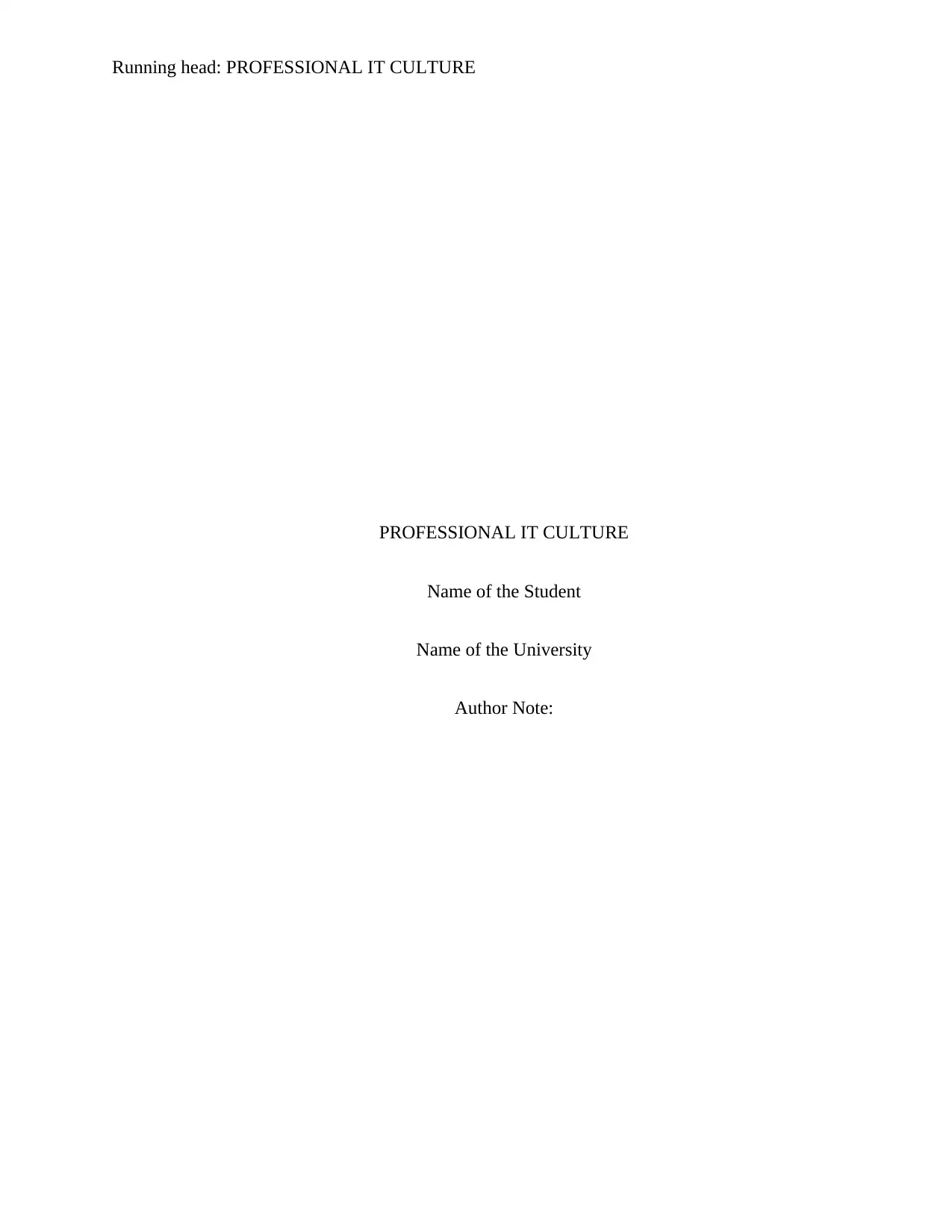
Running head: PROFESSIONAL IT CULTURE
PROFESSIONAL IT CULTURE
Name of the Student
Name of the University
Author Note:
PROFESSIONAL IT CULTURE
Name of the Student
Name of the University
Author Note:
Paraphrase This Document
Need a fresh take? Get an instant paraphrase of this document with our AI Paraphraser
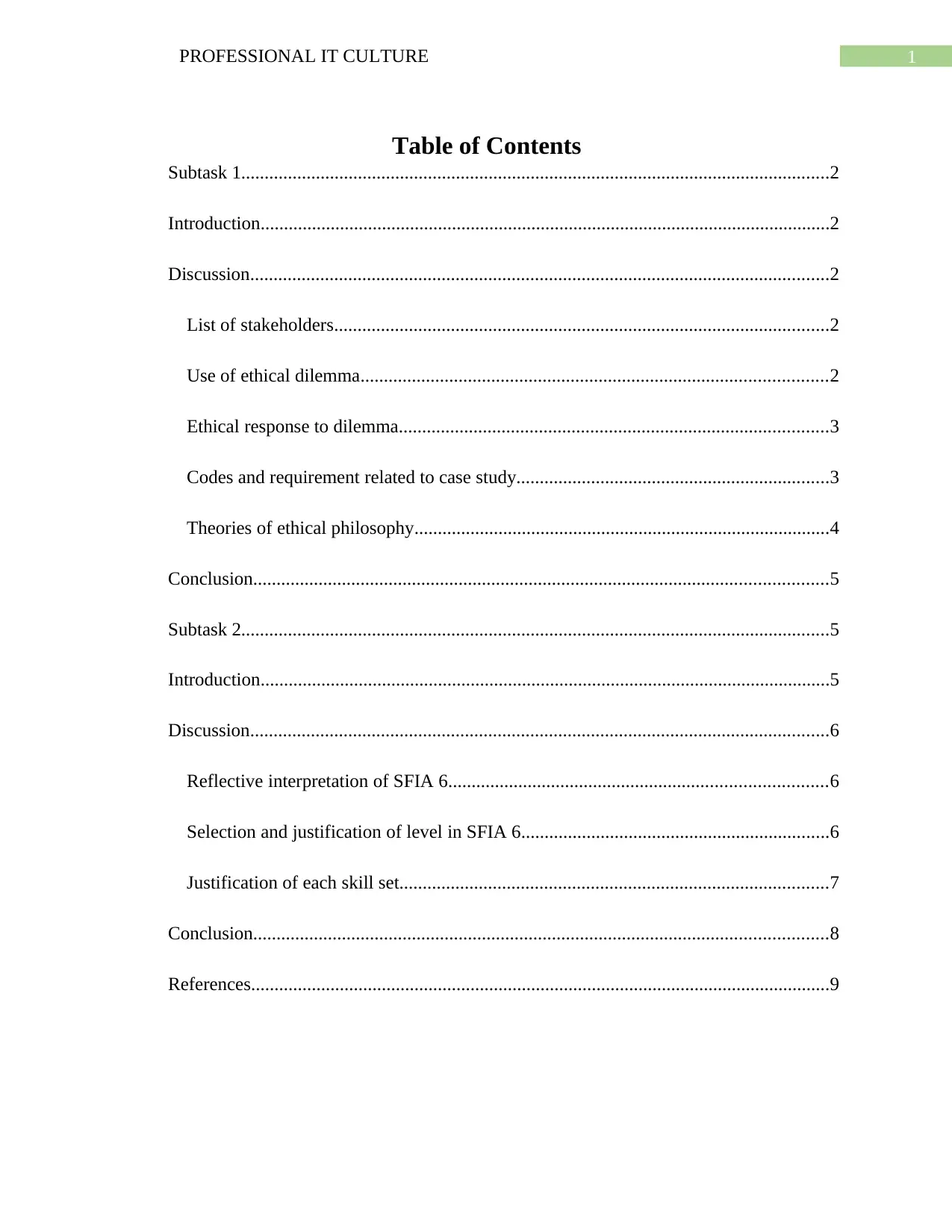
1PROFESSIONAL IT CULTURE
Table of Contents
Subtask 1..............................................................................................................................2
Introduction..........................................................................................................................2
Discussion............................................................................................................................2
List of stakeholders..........................................................................................................2
Use of ethical dilemma....................................................................................................2
Ethical response to dilemma............................................................................................3
Codes and requirement related to case study...................................................................3
Theories of ethical philosophy.........................................................................................4
Conclusion...........................................................................................................................5
Subtask 2..............................................................................................................................5
Introduction..........................................................................................................................5
Discussion............................................................................................................................6
Reflective interpretation of SFIA 6.................................................................................6
Selection and justification of level in SFIA 6..................................................................6
Justification of each skill set............................................................................................7
Conclusion...........................................................................................................................8
References............................................................................................................................9
Table of Contents
Subtask 1..............................................................................................................................2
Introduction..........................................................................................................................2
Discussion............................................................................................................................2
List of stakeholders..........................................................................................................2
Use of ethical dilemma....................................................................................................2
Ethical response to dilemma............................................................................................3
Codes and requirement related to case study...................................................................3
Theories of ethical philosophy.........................................................................................4
Conclusion...........................................................................................................................5
Subtask 2..............................................................................................................................5
Introduction..........................................................................................................................5
Discussion............................................................................................................................6
Reflective interpretation of SFIA 6.................................................................................6
Selection and justification of level in SFIA 6..................................................................6
Justification of each skill set............................................................................................7
Conclusion...........................................................................................................................8
References............................................................................................................................9
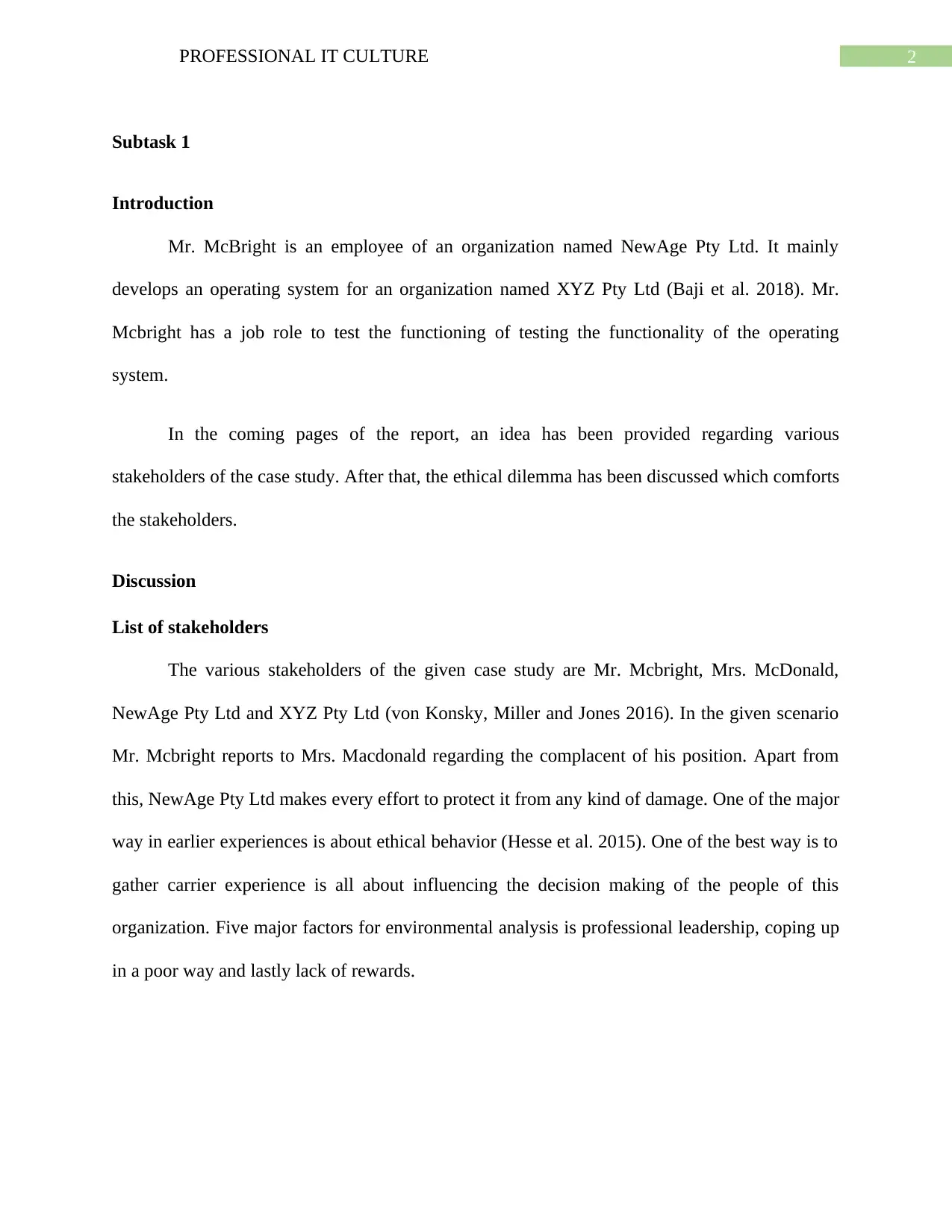
2PROFESSIONAL IT CULTURE
Subtask 1
Introduction
Mr. McBright is an employee of an organization named NewAge Pty Ltd. It mainly
develops an operating system for an organization named XYZ Pty Ltd (Baji et al. 2018). Mr.
Mcbright has a job role to test the functioning of testing the functionality of the operating
system.
In the coming pages of the report, an idea has been provided regarding various
stakeholders of the case study. After that, the ethical dilemma has been discussed which comforts
the stakeholders.
Discussion
List of stakeholders
The various stakeholders of the given case study are Mr. Mcbright, Mrs. McDonald,
NewAge Pty Ltd and XYZ Pty Ltd (von Konsky, Miller and Jones 2016). In the given scenario
Mr. Mcbright reports to Mrs. Macdonald regarding the complacent of his position. Apart from
this, NewAge Pty Ltd makes every effort to protect it from any kind of damage. One of the major
way in earlier experiences is about ethical behavior (Hesse et al. 2015). One of the best way is to
gather carrier experience is all about influencing the decision making of the people of this
organization. Five major factors for environmental analysis is professional leadership, coping up
in a poor way and lastly lack of rewards.
Subtask 1
Introduction
Mr. McBright is an employee of an organization named NewAge Pty Ltd. It mainly
develops an operating system for an organization named XYZ Pty Ltd (Baji et al. 2018). Mr.
Mcbright has a job role to test the functioning of testing the functionality of the operating
system.
In the coming pages of the report, an idea has been provided regarding various
stakeholders of the case study. After that, the ethical dilemma has been discussed which comforts
the stakeholders.
Discussion
List of stakeholders
The various stakeholders of the given case study are Mr. Mcbright, Mrs. McDonald,
NewAge Pty Ltd and XYZ Pty Ltd (von Konsky, Miller and Jones 2016). In the given scenario
Mr. Mcbright reports to Mrs. Macdonald regarding the complacent of his position. Apart from
this, NewAge Pty Ltd makes every effort to protect it from any kind of damage. One of the major
way in earlier experiences is about ethical behavior (Hesse et al. 2015). One of the best way is to
gather carrier experience is all about influencing the decision making of the people of this
organization. Five major factors for environmental analysis is professional leadership, coping up
in a poor way and lastly lack of rewards.
⊘ This is a preview!⊘
Do you want full access?
Subscribe today to unlock all pages.

Trusted by 1+ million students worldwide
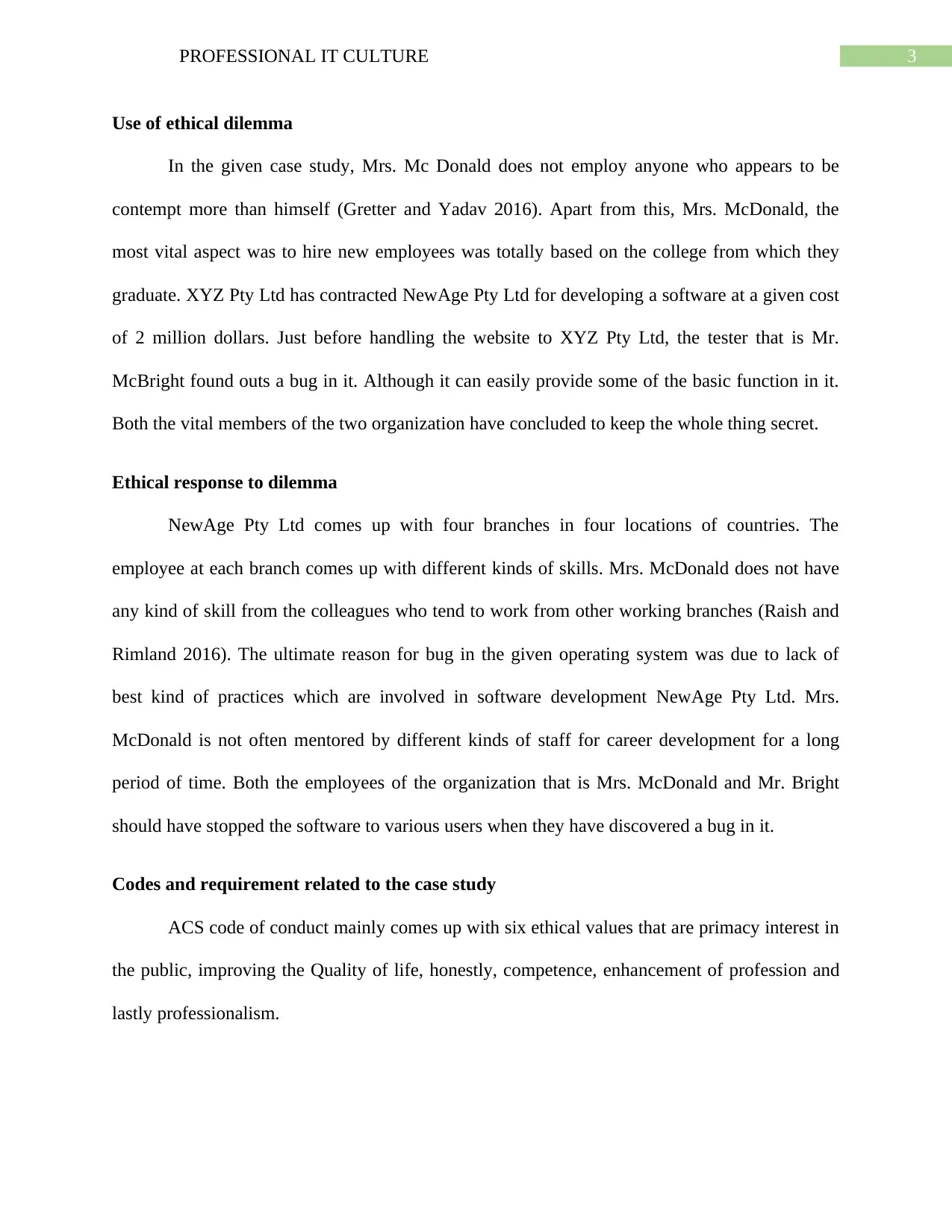
3PROFESSIONAL IT CULTURE
Use of ethical dilemma
In the given case study, Mrs. Mc Donald does not employ anyone who appears to be
contempt more than himself (Gretter and Yadav 2016). Apart from this, Mrs. McDonald, the
most vital aspect was to hire new employees was totally based on the college from which they
graduate. XYZ Pty Ltd has contracted NewAge Pty Ltd for developing a software at a given cost
of 2 million dollars. Just before handling the website to XYZ Pty Ltd, the tester that is Mr.
McBright found outs a bug in it. Although it can easily provide some of the basic function in it.
Both the vital members of the two organization have concluded to keep the whole thing secret.
Ethical response to dilemma
NewAge Pty Ltd comes up with four branches in four locations of countries. The
employee at each branch comes up with different kinds of skills. Mrs. McDonald does not have
any kind of skill from the colleagues who tend to work from other working branches (Raish and
Rimland 2016). The ultimate reason for bug in the given operating system was due to lack of
best kind of practices which are involved in software development NewAge Pty Ltd. Mrs.
McDonald is not often mentored by different kinds of staff for career development for a long
period of time. Both the employees of the organization that is Mrs. McDonald and Mr. Bright
should have stopped the software to various users when they have discovered a bug in it.
Codes and requirement related to the case study
ACS code of conduct mainly comes up with six ethical values that are primacy interest in
the public, improving the Quality of life, honestly, competence, enhancement of profession and
lastly professionalism.
Use of ethical dilemma
In the given case study, Mrs. Mc Donald does not employ anyone who appears to be
contempt more than himself (Gretter and Yadav 2016). Apart from this, Mrs. McDonald, the
most vital aspect was to hire new employees was totally based on the college from which they
graduate. XYZ Pty Ltd has contracted NewAge Pty Ltd for developing a software at a given cost
of 2 million dollars. Just before handling the website to XYZ Pty Ltd, the tester that is Mr.
McBright found outs a bug in it. Although it can easily provide some of the basic function in it.
Both the vital members of the two organization have concluded to keep the whole thing secret.
Ethical response to dilemma
NewAge Pty Ltd comes up with four branches in four locations of countries. The
employee at each branch comes up with different kinds of skills. Mrs. McDonald does not have
any kind of skill from the colleagues who tend to work from other working branches (Raish and
Rimland 2016). The ultimate reason for bug in the given operating system was due to lack of
best kind of practices which are involved in software development NewAge Pty Ltd. Mrs.
McDonald is not often mentored by different kinds of staff for career development for a long
period of time. Both the employees of the organization that is Mrs. McDonald and Mr. Bright
should have stopped the software to various users when they have discovered a bug in it.
Codes and requirement related to the case study
ACS code of conduct mainly comes up with six ethical values that are primacy interest in
the public, improving the Quality of life, honestly, competence, enhancement of profession and
lastly professionalism.
Paraphrase This Document
Need a fresh take? Get an instant paraphrase of this document with our AI Paraphraser
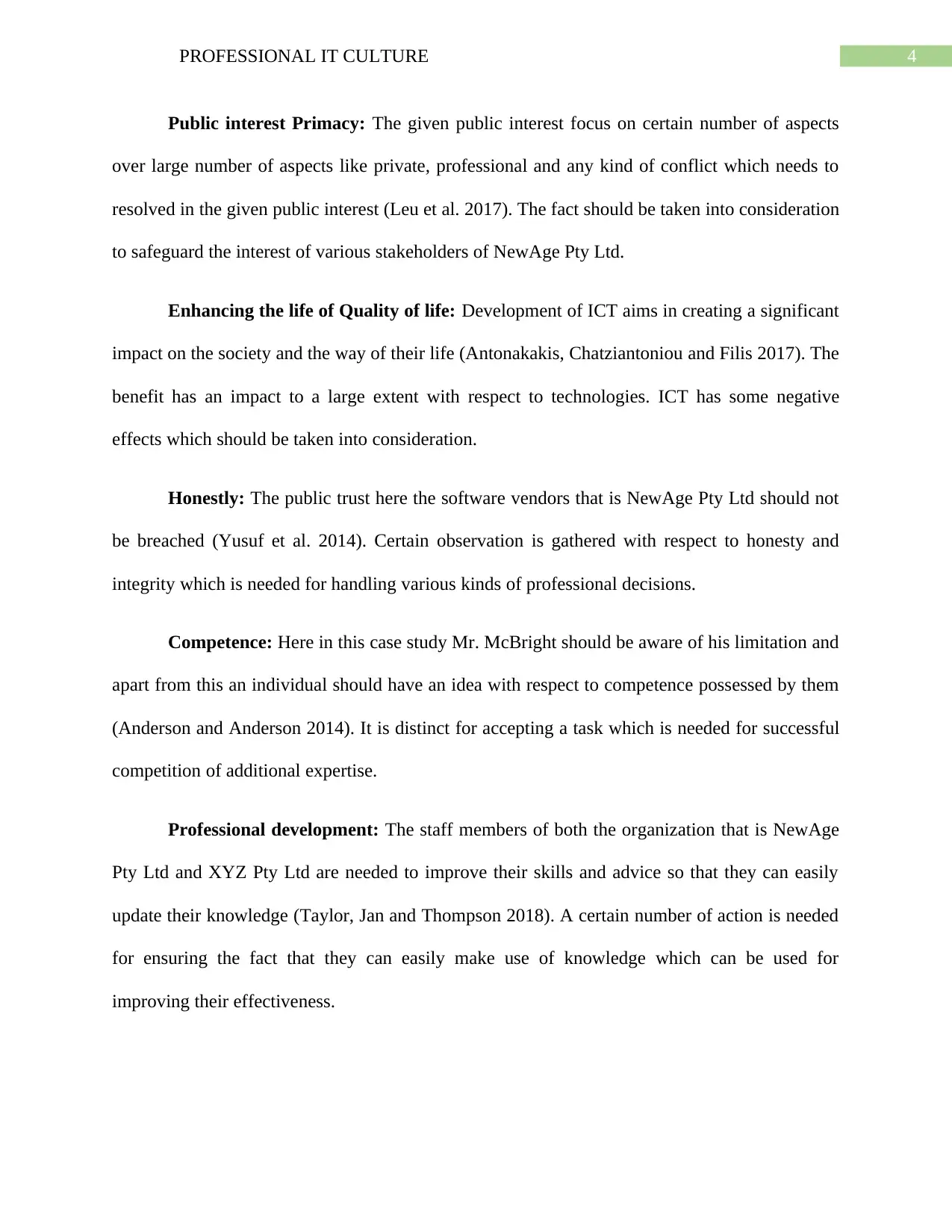
4PROFESSIONAL IT CULTURE
Public interest Primacy: The given public interest focus on certain number of aspects
over large number of aspects like private, professional and any kind of conflict which needs to
resolved in the given public interest (Leu et al. 2017). The fact should be taken into consideration
to safeguard the interest of various stakeholders of NewAge Pty Ltd.
Enhancing the life of Quality of life: Development of ICT aims in creating a significant
impact on the society and the way of their life (Antonakakis, Chatziantoniou and Filis 2017). The
benefit has an impact to a large extent with respect to technologies. ICT has some negative
effects which should be taken into consideration.
Honestly: The public trust here the software vendors that is NewAge Pty Ltd should not
be breached (Yusuf et al. 2014). Certain observation is gathered with respect to honesty and
integrity which is needed for handling various kinds of professional decisions.
Competence: Here in this case study Mr. McBright should be aware of his limitation and
apart from this an individual should have an idea with respect to competence possessed by them
(Anderson and Anderson 2014). It is distinct for accepting a task which is needed for successful
competition of additional expertise.
Professional development: The staff members of both the organization that is NewAge
Pty Ltd and XYZ Pty Ltd are needed to improve their skills and advice so that they can easily
update their knowledge (Taylor, Jan and Thompson 2018). A certain number of action is needed
for ensuring the fact that they can easily make use of knowledge which can be used for
improving their effectiveness.
Public interest Primacy: The given public interest focus on certain number of aspects
over large number of aspects like private, professional and any kind of conflict which needs to
resolved in the given public interest (Leu et al. 2017). The fact should be taken into consideration
to safeguard the interest of various stakeholders of NewAge Pty Ltd.
Enhancing the life of Quality of life: Development of ICT aims in creating a significant
impact on the society and the way of their life (Antonakakis, Chatziantoniou and Filis 2017). The
benefit has an impact to a large extent with respect to technologies. ICT has some negative
effects which should be taken into consideration.
Honestly: The public trust here the software vendors that is NewAge Pty Ltd should not
be breached (Yusuf et al. 2014). Certain observation is gathered with respect to honesty and
integrity which is needed for handling various kinds of professional decisions.
Competence: Here in this case study Mr. McBright should be aware of his limitation and
apart from this an individual should have an idea with respect to competence possessed by them
(Anderson and Anderson 2014). It is distinct for accepting a task which is needed for successful
competition of additional expertise.
Professional development: The staff members of both the organization that is NewAge
Pty Ltd and XYZ Pty Ltd are needed to improve their skills and advice so that they can easily
update their knowledge (Taylor, Jan and Thompson 2018). A certain number of action is needed
for ensuring the fact that they can easily make use of knowledge which can be used for
improving their effectiveness.
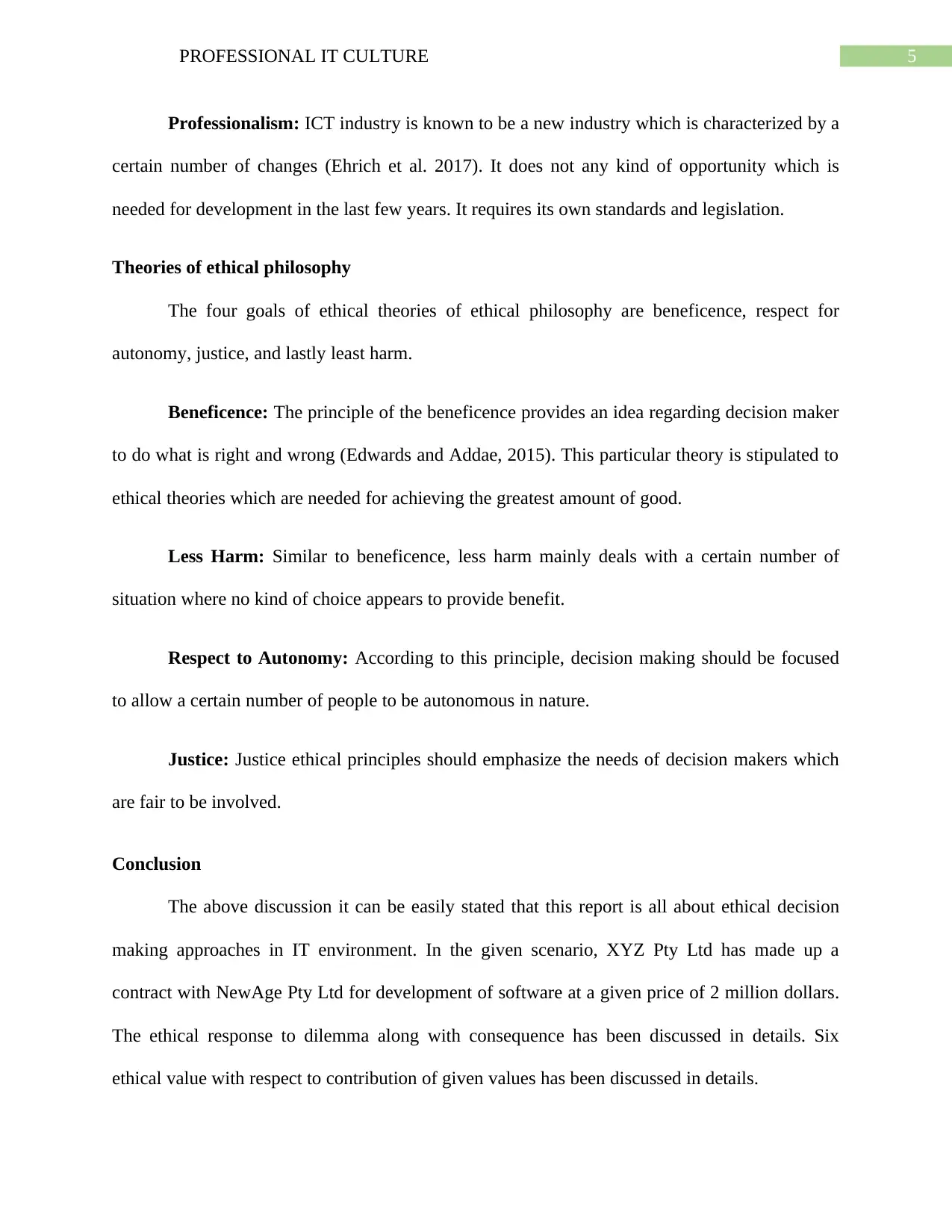
5PROFESSIONAL IT CULTURE
Professionalism: ICT industry is known to be a new industry which is characterized by a
certain number of changes (Ehrich et al. 2017). It does not any kind of opportunity which is
needed for development in the last few years. It requires its own standards and legislation.
Theories of ethical philosophy
The four goals of ethical theories of ethical philosophy are beneficence, respect for
autonomy, justice, and lastly least harm.
Beneficence: The principle of the beneficence provides an idea regarding decision maker
to do what is right and wrong (Edwards and Addae, 2015). This particular theory is stipulated to
ethical theories which are needed for achieving the greatest amount of good.
Less Harm: Similar to beneficence, less harm mainly deals with a certain number of
situation where no kind of choice appears to provide benefit.
Respect to Autonomy: According to this principle, decision making should be focused
to allow a certain number of people to be autonomous in nature.
Justice: Justice ethical principles should emphasize the needs of decision makers which
are fair to be involved.
Conclusion
The above discussion it can be easily stated that this report is all about ethical decision
making approaches in IT environment. In the given scenario, XYZ Pty Ltd has made up a
contract with NewAge Pty Ltd for development of software at a given price of 2 million dollars.
The ethical response to dilemma along with consequence has been discussed in details. Six
ethical value with respect to contribution of given values has been discussed in details.
Professionalism: ICT industry is known to be a new industry which is characterized by a
certain number of changes (Ehrich et al. 2017). It does not any kind of opportunity which is
needed for development in the last few years. It requires its own standards and legislation.
Theories of ethical philosophy
The four goals of ethical theories of ethical philosophy are beneficence, respect for
autonomy, justice, and lastly least harm.
Beneficence: The principle of the beneficence provides an idea regarding decision maker
to do what is right and wrong (Edwards and Addae, 2015). This particular theory is stipulated to
ethical theories which are needed for achieving the greatest amount of good.
Less Harm: Similar to beneficence, less harm mainly deals with a certain number of
situation where no kind of choice appears to provide benefit.
Respect to Autonomy: According to this principle, decision making should be focused
to allow a certain number of people to be autonomous in nature.
Justice: Justice ethical principles should emphasize the needs of decision makers which
are fair to be involved.
Conclusion
The above discussion it can be easily stated that this report is all about ethical decision
making approaches in IT environment. In the given scenario, XYZ Pty Ltd has made up a
contract with NewAge Pty Ltd for development of software at a given price of 2 million dollars.
The ethical response to dilemma along with consequence has been discussed in details. Six
ethical value with respect to contribution of given values has been discussed in details.
⊘ This is a preview!⊘
Do you want full access?
Subscribe today to unlock all pages.

Trusted by 1+ million students worldwide
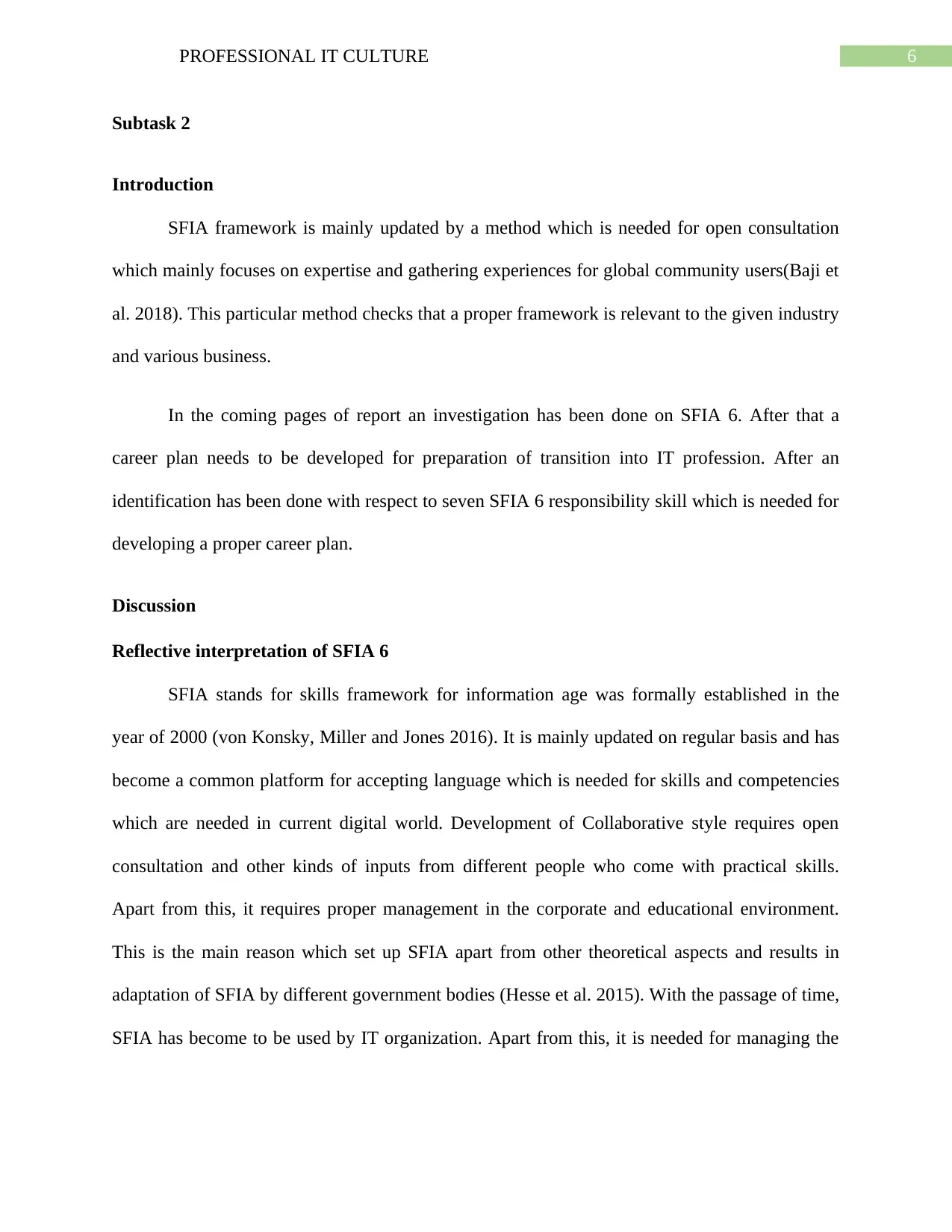
6PROFESSIONAL IT CULTURE
Subtask 2
Introduction
SFIA framework is mainly updated by a method which is needed for open consultation
which mainly focuses on expertise and gathering experiences for global community users(Baji et
al. 2018). This particular method checks that a proper framework is relevant to the given industry
and various business.
In the coming pages of report an investigation has been done on SFIA 6. After that a
career plan needs to be developed for preparation of transition into IT profession. After an
identification has been done with respect to seven SFIA 6 responsibility skill which is needed for
developing a proper career plan.
Discussion
Reflective interpretation of SFIA 6
SFIA stands for skills framework for information age was formally established in the
year of 2000 (von Konsky, Miller and Jones 2016). It is mainly updated on regular basis and has
become a common platform for accepting language which is needed for skills and competencies
which are needed in current digital world. Development of Collaborative style requires open
consultation and other kinds of inputs from different people who come with practical skills.
Apart from this, it requires proper management in the corporate and educational environment.
This is the main reason which set up SFIA apart from other theoretical aspects and results in
adaptation of SFIA by different government bodies (Hesse et al. 2015). With the passage of time,
SFIA has become to be used by IT organization. Apart from this, it is needed for managing the
Subtask 2
Introduction
SFIA framework is mainly updated by a method which is needed for open consultation
which mainly focuses on expertise and gathering experiences for global community users(Baji et
al. 2018). This particular method checks that a proper framework is relevant to the given industry
and various business.
In the coming pages of report an investigation has been done on SFIA 6. After that a
career plan needs to be developed for preparation of transition into IT profession. After an
identification has been done with respect to seven SFIA 6 responsibility skill which is needed for
developing a proper career plan.
Discussion
Reflective interpretation of SFIA 6
SFIA stands for skills framework for information age was formally established in the
year of 2000 (von Konsky, Miller and Jones 2016). It is mainly updated on regular basis and has
become a common platform for accepting language which is needed for skills and competencies
which are needed in current digital world. Development of Collaborative style requires open
consultation and other kinds of inputs from different people who come with practical skills.
Apart from this, it requires proper management in the corporate and educational environment.
This is the main reason which set up SFIA apart from other theoretical aspects and results in
adaptation of SFIA by different government bodies (Hesse et al. 2015). With the passage of time,
SFIA has become to be used by IT organization. Apart from this, it is needed for managing the
Paraphrase This Document
Need a fresh take? Get an instant paraphrase of this document with our AI Paraphraser
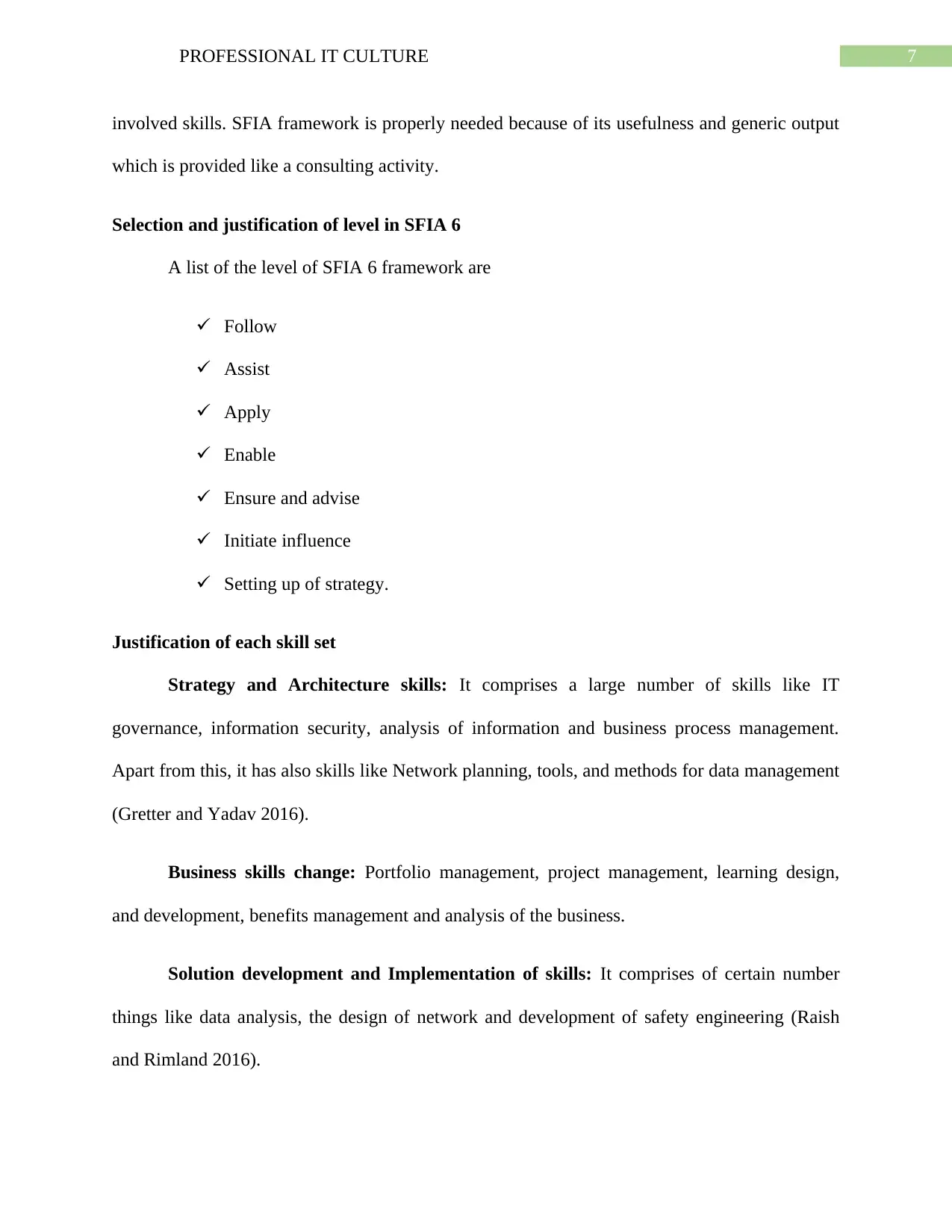
7PROFESSIONAL IT CULTURE
involved skills. SFIA framework is properly needed because of its usefulness and generic output
which is provided like a consulting activity.
Selection and justification of level in SFIA 6
A list of the level of SFIA 6 framework are
Follow
Assist
Apply
Enable
Ensure and advise
Initiate influence
Setting up of strategy.
Justification of each skill set
Strategy and Architecture skills: It comprises a large number of skills like IT
governance, information security, analysis of information and business process management.
Apart from this, it has also skills like Network planning, tools, and methods for data management
(Gretter and Yadav 2016).
Business skills change: Portfolio management, project management, learning design,
and development, benefits management and analysis of the business.
Solution development and Implementation of skills: It comprises of certain number
things like data analysis, the design of network and development of safety engineering (Raish
and Rimland 2016).
involved skills. SFIA framework is properly needed because of its usefulness and generic output
which is provided like a consulting activity.
Selection and justification of level in SFIA 6
A list of the level of SFIA 6 framework are
Follow
Assist
Apply
Enable
Ensure and advise
Initiate influence
Setting up of strategy.
Justification of each skill set
Strategy and Architecture skills: It comprises a large number of skills like IT
governance, information security, analysis of information and business process management.
Apart from this, it has also skills like Network planning, tools, and methods for data management
(Gretter and Yadav 2016).
Business skills change: Portfolio management, project management, learning design,
and development, benefits management and analysis of the business.
Solution development and Implementation of skills: It comprises of certain number
things like data analysis, the design of network and development of safety engineering (Raish
and Rimland 2016).
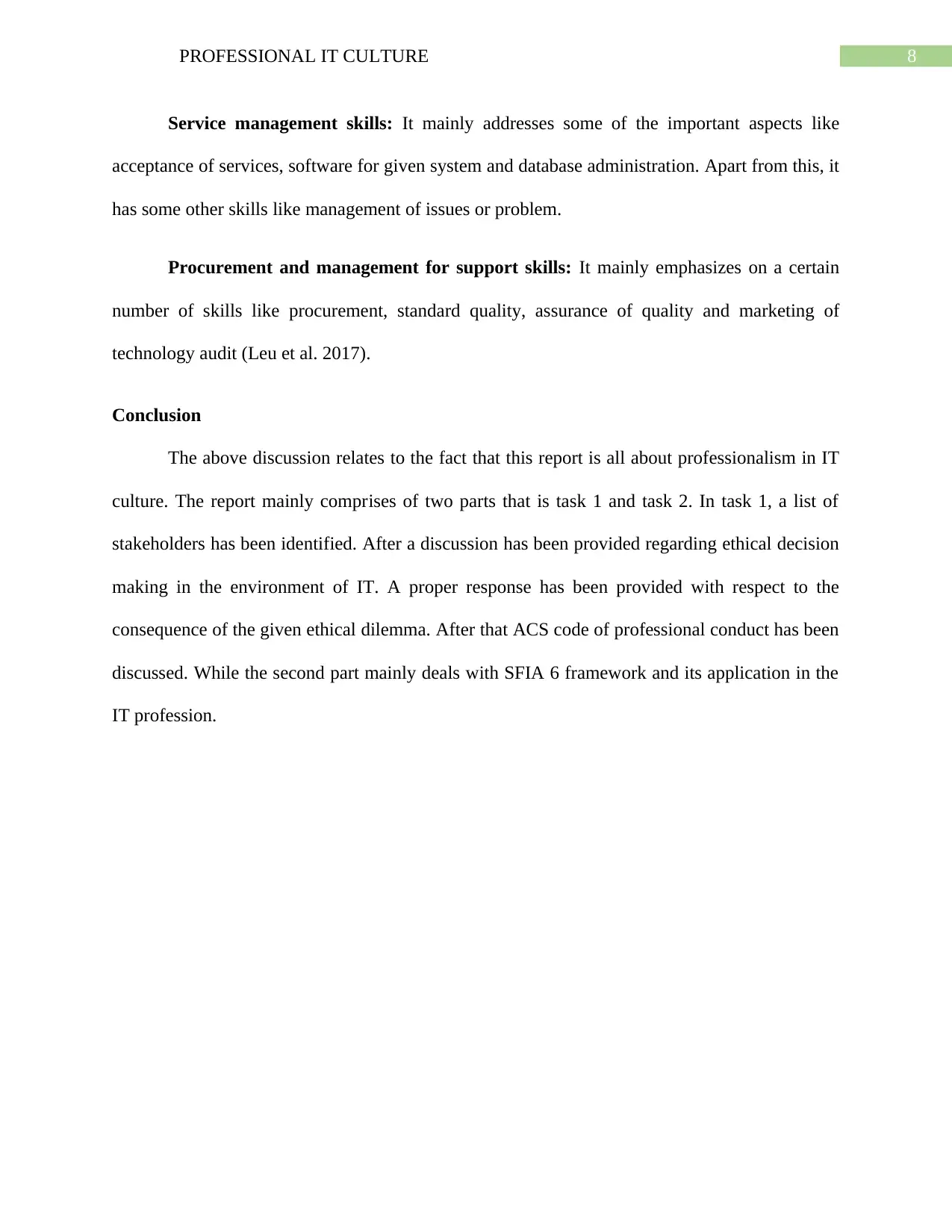
8PROFESSIONAL IT CULTURE
Service management skills: It mainly addresses some of the important aspects like
acceptance of services, software for given system and database administration. Apart from this, it
has some other skills like management of issues or problem.
Procurement and management for support skills: It mainly emphasizes on a certain
number of skills like procurement, standard quality, assurance of quality and marketing of
technology audit (Leu et al. 2017).
Conclusion
The above discussion relates to the fact that this report is all about professionalism in IT
culture. The report mainly comprises of two parts that is task 1 and task 2. In task 1, a list of
stakeholders has been identified. After a discussion has been provided regarding ethical decision
making in the environment of IT. A proper response has been provided with respect to the
consequence of the given ethical dilemma. After that ACS code of professional conduct has been
discussed. While the second part mainly deals with SFIA 6 framework and its application in the
IT profession.
Service management skills: It mainly addresses some of the important aspects like
acceptance of services, software for given system and database administration. Apart from this, it
has some other skills like management of issues or problem.
Procurement and management for support skills: It mainly emphasizes on a certain
number of skills like procurement, standard quality, assurance of quality and marketing of
technology audit (Leu et al. 2017).
Conclusion
The above discussion relates to the fact that this report is all about professionalism in IT
culture. The report mainly comprises of two parts that is task 1 and task 2. In task 1, a list of
stakeholders has been identified. After a discussion has been provided regarding ethical decision
making in the environment of IT. A proper response has been provided with respect to the
consequence of the given ethical dilemma. After that ACS code of professional conduct has been
discussed. While the second part mainly deals with SFIA 6 framework and its application in the
IT profession.
⊘ This is a preview!⊘
Do you want full access?
Subscribe today to unlock all pages.

Trusted by 1+ million students worldwide
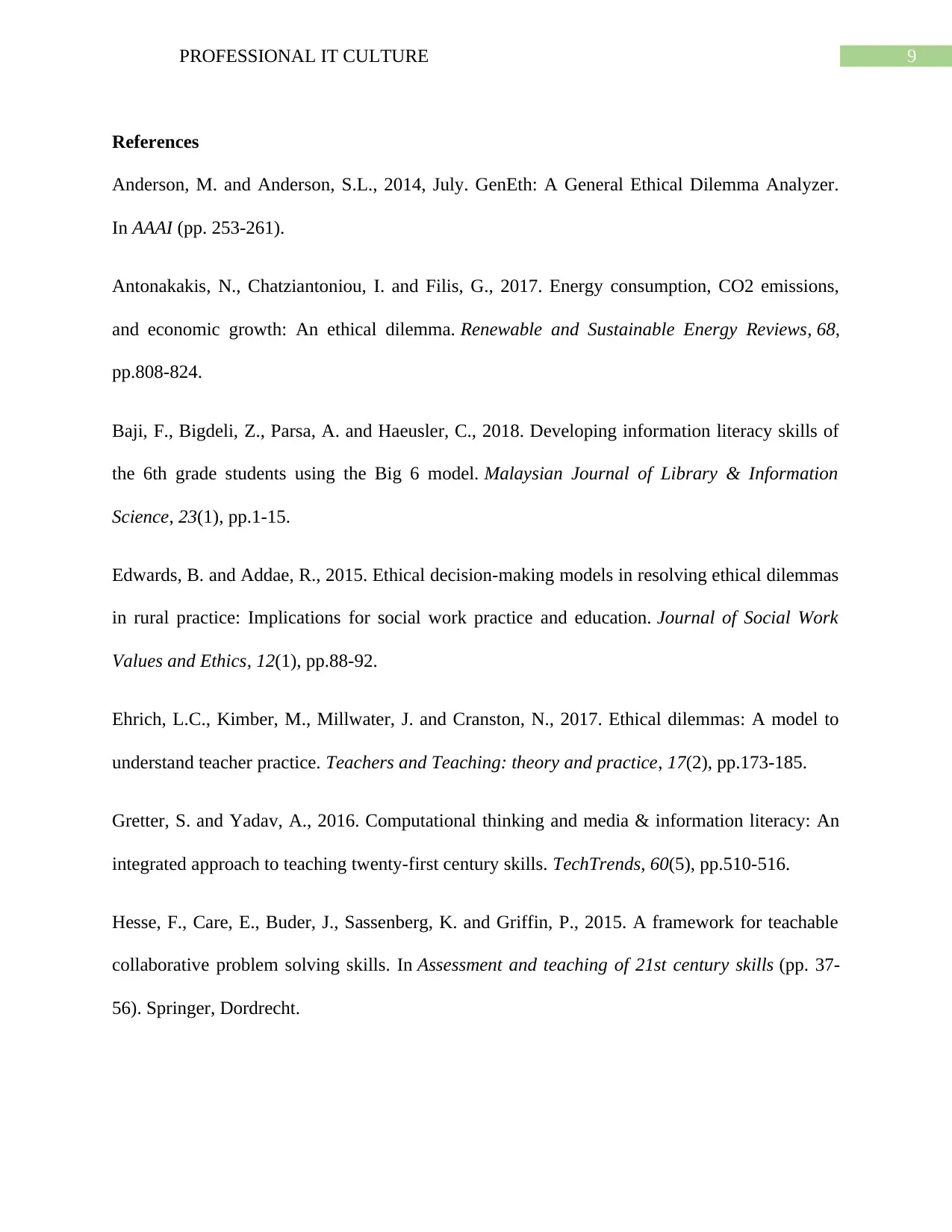
9PROFESSIONAL IT CULTURE
References
Anderson, M. and Anderson, S.L., 2014, July. GenEth: A General Ethical Dilemma Analyzer.
In AAAI (pp. 253-261).
Antonakakis, N., Chatziantoniou, I. and Filis, G., 2017. Energy consumption, CO2 emissions,
and economic growth: An ethical dilemma. Renewable and Sustainable Energy Reviews, 68,
pp.808-824.
Baji, F., Bigdeli, Z., Parsa, A. and Haeusler, C., 2018. Developing information literacy skills of
the 6th grade students using the Big 6 model. Malaysian Journal of Library & Information
Science, 23(1), pp.1-15.
Edwards, B. and Addae, R., 2015. Ethical decision-making models in resolving ethical dilemmas
in rural practice: Implications for social work practice and education. Journal of Social Work
Values and Ethics, 12(1), pp.88-92.
Ehrich, L.C., Kimber, M., Millwater, J. and Cranston, N., 2017. Ethical dilemmas: A model to
understand teacher practice. Teachers and Teaching: theory and practice, 17(2), pp.173-185.
Gretter, S. and Yadav, A., 2016. Computational thinking and media & information literacy: An
integrated approach to teaching twenty-first century skills. TechTrends, 60(5), pp.510-516.
Hesse, F., Care, E., Buder, J., Sassenberg, K. and Griffin, P., 2015. A framework for teachable
collaborative problem solving skills. In Assessment and teaching of 21st century skills (pp. 37-
56). Springer, Dordrecht.
References
Anderson, M. and Anderson, S.L., 2014, July. GenEth: A General Ethical Dilemma Analyzer.
In AAAI (pp. 253-261).
Antonakakis, N., Chatziantoniou, I. and Filis, G., 2017. Energy consumption, CO2 emissions,
and economic growth: An ethical dilemma. Renewable and Sustainable Energy Reviews, 68,
pp.808-824.
Baji, F., Bigdeli, Z., Parsa, A. and Haeusler, C., 2018. Developing information literacy skills of
the 6th grade students using the Big 6 model. Malaysian Journal of Library & Information
Science, 23(1), pp.1-15.
Edwards, B. and Addae, R., 2015. Ethical decision-making models in resolving ethical dilemmas
in rural practice: Implications for social work practice and education. Journal of Social Work
Values and Ethics, 12(1), pp.88-92.
Ehrich, L.C., Kimber, M., Millwater, J. and Cranston, N., 2017. Ethical dilemmas: A model to
understand teacher practice. Teachers and Teaching: theory and practice, 17(2), pp.173-185.
Gretter, S. and Yadav, A., 2016. Computational thinking and media & information literacy: An
integrated approach to teaching twenty-first century skills. TechTrends, 60(5), pp.510-516.
Hesse, F., Care, E., Buder, J., Sassenberg, K. and Griffin, P., 2015. A framework for teachable
collaborative problem solving skills. In Assessment and teaching of 21st century skills (pp. 37-
56). Springer, Dordrecht.
Paraphrase This Document
Need a fresh take? Get an instant paraphrase of this document with our AI Paraphraser
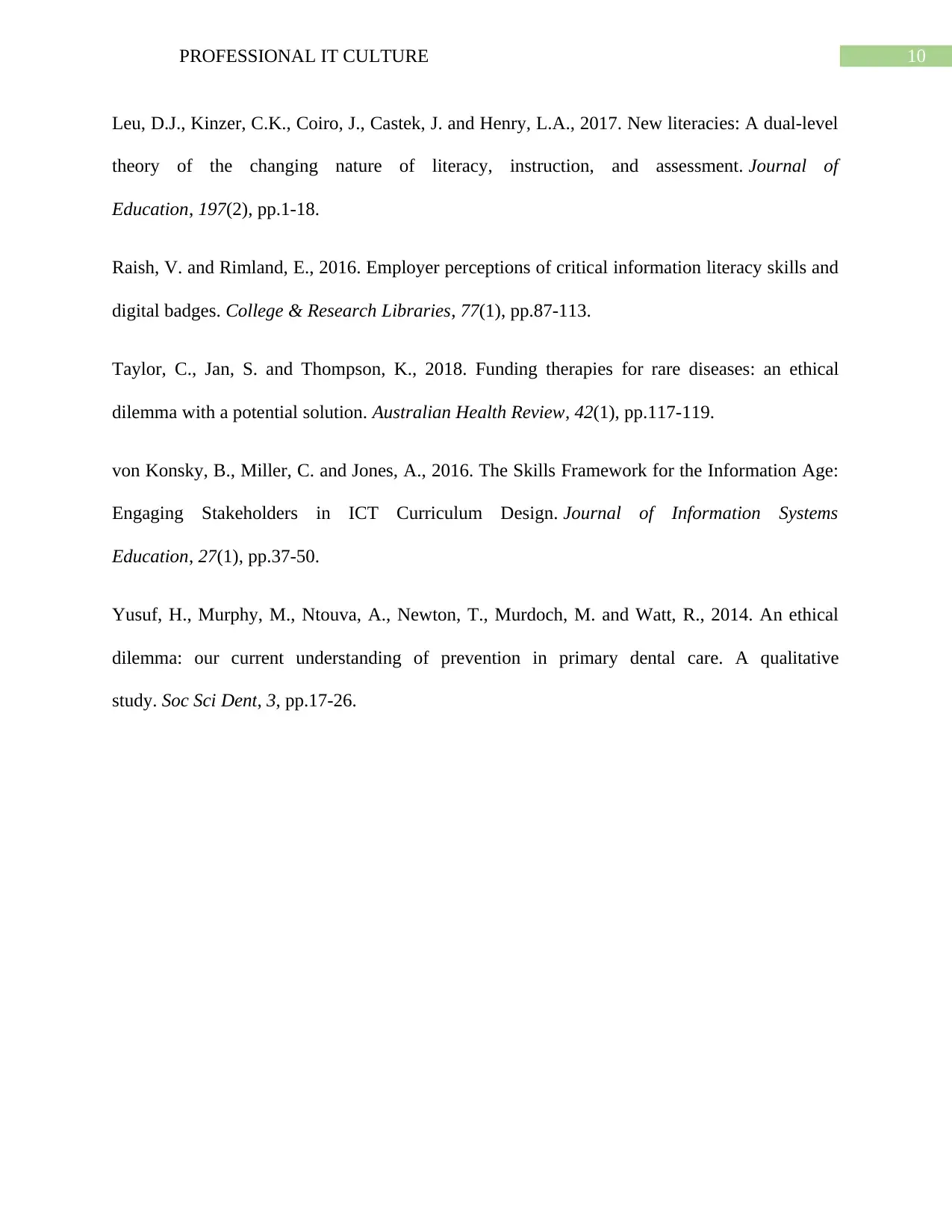
10PROFESSIONAL IT CULTURE
Leu, D.J., Kinzer, C.K., Coiro, J., Castek, J. and Henry, L.A., 2017. New literacies: A dual-level
theory of the changing nature of literacy, instruction, and assessment. Journal of
Education, 197(2), pp.1-18.
Raish, V. and Rimland, E., 2016. Employer perceptions of critical information literacy skills and
digital badges. College & Research Libraries, 77(1), pp.87-113.
Taylor, C., Jan, S. and Thompson, K., 2018. Funding therapies for rare diseases: an ethical
dilemma with a potential solution. Australian Health Review, 42(1), pp.117-119.
von Konsky, B., Miller, C. and Jones, A., 2016. The Skills Framework for the Information Age:
Engaging Stakeholders in ICT Curriculum Design. Journal of Information Systems
Education, 27(1), pp.37-50.
Yusuf, H., Murphy, M., Ntouva, A., Newton, T., Murdoch, M. and Watt, R., 2014. An ethical
dilemma: our current understanding of prevention in primary dental care. A qualitative
study. Soc Sci Dent, 3, pp.17-26.
Leu, D.J., Kinzer, C.K., Coiro, J., Castek, J. and Henry, L.A., 2017. New literacies: A dual-level
theory of the changing nature of literacy, instruction, and assessment. Journal of
Education, 197(2), pp.1-18.
Raish, V. and Rimland, E., 2016. Employer perceptions of critical information literacy skills and
digital badges. College & Research Libraries, 77(1), pp.87-113.
Taylor, C., Jan, S. and Thompson, K., 2018. Funding therapies for rare diseases: an ethical
dilemma with a potential solution. Australian Health Review, 42(1), pp.117-119.
von Konsky, B., Miller, C. and Jones, A., 2016. The Skills Framework for the Information Age:
Engaging Stakeholders in ICT Curriculum Design. Journal of Information Systems
Education, 27(1), pp.37-50.
Yusuf, H., Murphy, M., Ntouva, A., Newton, T., Murdoch, M. and Watt, R., 2014. An ethical
dilemma: our current understanding of prevention in primary dental care. A qualitative
study. Soc Sci Dent, 3, pp.17-26.
1 out of 11
Related Documents
Your All-in-One AI-Powered Toolkit for Academic Success.
+13062052269
info@desklib.com
Available 24*7 on WhatsApp / Email
![[object Object]](/_next/static/media/star-bottom.7253800d.svg)
Unlock your academic potential
Copyright © 2020–2025 A2Z Services. All Rights Reserved. Developed and managed by ZUCOL.




